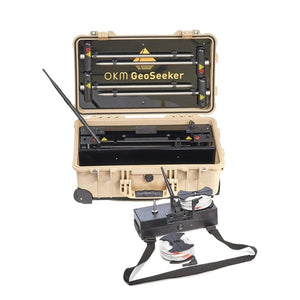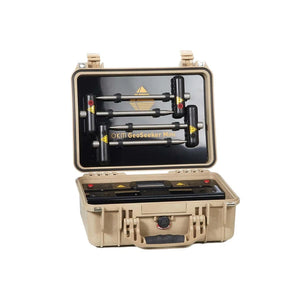A GPR metal detector, more accurately referred to as a Ground Penetrating Radar (GPR), is different from a traditional metal detector in several ways. Here's a breakdown of the key differences:
Technology:
- Traditional metal detectors: These devices use electromagnetic induction to detect the presence of metal objects. They transmit a low-frequency electromagnetic field and then detect the distortion caused by nearby metal objects.
- GPR: These devices use radar pulses to map the subsurface. They transmit short bursts of electromagnetic energy into the ground and then analyze the reflected signals to create an image of what's buried beneath.
Target detection:
- Traditional metal detectors: These devices can only detect metallic objects. They cannot distinguish between different types of metals or determine the size or shape of the object.
- GPR: These devices can detect a variety of objects, including metal, plastic, concrete, and even voids in the ground. They can also provide an estimate of the size and shape of the object.
Depth of detection:
- Traditional metal detectors: The depth of detection varies depending on the model and the size and type of metal object. Generally, they can detect objects buried up to a few feet deep.
- GPR: GPR can detect objects buried much deeper than traditional metal detectors. In ideal conditions, they can detect objects buried tens of meters deep.
Applications:
- Traditional metal detectors: These devices are commonly used for hobbyists to find coins, jewelry, and other metal objects. They are also used by law enforcement and security personnel to detect weapons and other contraband.
- GPR: These devices have a wider range of applications. They are used by archaeologists to locate buried structures and artifacts, by engineers to survey underground utilities and infrastructure, by geologists to map the subsurface, and by environmental scientists to locate buried contaminants.
Here's a table summarizing the key differences:
| Feature | Traditional Metal Detector | GPR |
|---|---|---|
| Technology | Electromagnetic induction | Ground Penetrating Radar |
| Target detection | Metal only | Various materials |
| Depth of detection | Up to a few feet | Tens of meters |
| Applications | Hobbyists, law enforcement, security | Archaeology, engineering, geology, environmental science |
So, a GPR is not technically a metal detector, although it can be used to locate metal objects. It's a more versatile and powerful tool that can be used for a variety of applications.
OKM metal detectors have gained a reputation for producing high-quality GPR (Ground Penetrating Radar) for several key reasons:
1. German Engineering and Expertise: OKM is a German company with over 25 years of experience in developing and manufacturing metal detectors and GPR systems. Their commitment to German engineering standards ensures high-quality components, meticulous assembly, and rigorous testing. This results in reliable and durable instruments built to withstand demanding field conditions.
2. Innovation and Advanced Technology: OKM consistently invests in research and development, pushing the boundaries of GPR technology. They incorporate cutting-edge features like Multi-Frequency GPR, 3D Visualization Software, and advanced signal processing algorithms to enhance detection performance and provide detailed information about buried objects.
3. User-friendliness: OKM strives to make its GPR systems accessible to users of all skill levels. They design their devices with intuitive interfaces, user-friendly software, and comprehensive training materials. This ensures that anyone, even with limited experience, can quickly learn to operate an OKM GPR system and achieve optimal results.
4. Application-specific solutions: OKM offers a diverse range of GPR systems tailored to specific applications. Whether you're an archaeologist searching for buried ruins, a utility locator mapping underground infrastructure, or a treasure hunter seeking hidden valuables, OKM has a GPR system designed to meet your specific needs and maximize your success.
5. Excellent customer support: OKM provides excellent customer support to ensure users have a positive experience with their products. They offer technical support, training resources, and ongoing software updates to help users get the most out of their GPR systems.
Here are some specific examples of how OKM's commitment to these factors translates into high-quality GPR detectors:
- OKM Gepard GPR: This system features a powerful radar unit with a wide range of frequencies, allowing for deep penetration and detection of various objects. The included 3D visualization software provides detailed images of the subsurface, aiding in accurate interpretation and target identification.
- OKM Rover C4: This portable and lightweight GPR system is ideal for field surveys and archaeological exploration. Its user-friendly interface and intuitive software make it easy to operate, even in challenging field conditions.
- OKM Fusion : This advanced GPR system combines GPR technology with metal detection capabilities, offering unparalleled versatility and target information. It's a powerful tool for treasure hunters, archaeologists, and professional surveyors seeking maximum detection depth and object identification.
Overall, OKM's commitment to German engineering, innovation, user-friendliness, application-specific solutions, and excellent customer support has earned them a reputation for producing high-quality GPR metal detectors. These factors contribute to their success in providing reliable, robust, and versatile instruments that cater to the diverse needs of a wide range of users.






Leave a comment